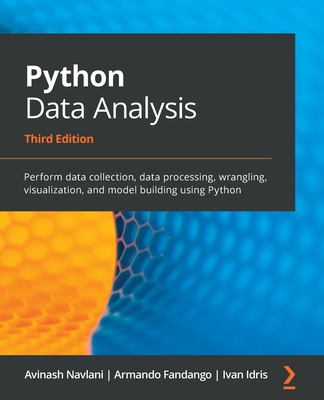Beginning Python Visualization: Crafting Visual Transformation Scripts, 2/e (Paperback)
暫譯: Python 視覺化入門:製作視覺轉換腳本(第二版)
Shai Vaingast
- 出版商: Apress
- 出版日期: 2014-08-16
- 定價: $1,980
- 售價: 9.5 折 $1,881
- 語言: 英文
- 頁數: 416
- 裝訂: Paperback
- ISBN: 1484200535
- ISBN-13: 9781484200537
-
相關分類:
Data-visualization
立即出貨 (庫存=1)
買這商品的人也買了...
-
 程式設計師的自我修養-連結、載入、程式庫
程式設計師的自我修養-連結、載入、程式庫$580$458 -
 精通 Python 3 程式設計, 2/e (Programming in Python 3: A Complete Introduction to the Python Language, 2/e)
精通 Python 3 程式設計, 2/e (Programming in Python 3: A Complete Introduction to the Python Language, 2/e)$680$537 -
 版本控制使用 Git, 2/e (Version Control with Git: Powerful tools and techniques for collaborative software development, 2/e)
版本控制使用 Git, 2/e (Version Control with Git: Powerful tools and techniques for collaborative software development, 2/e)$580$458 -
 王者歸來 Java Web 整合開發-JSP + Servlet + Struts + Hibernate + Spring, 3/e
王者歸來 Java Web 整合開發-JSP + Servlet + Struts + Hibernate + Spring, 3/e$980$833 -
 Arduino UNO R3 開發板(副廠相容版)附傳輸線
Arduino UNO R3 開發板(副廠相容版)附傳輸線$400$380 -
 透視 C語言指標-深度探索記憶體管理核心技術 (Understanding and Using C Pointers)
透視 C語言指標-深度探索記憶體管理核心技術 (Understanding and Using C Pointers)$480$379 -
 超圖解 Arduino 互動設計入門, 2/e
超圖解 Arduino 互動設計入門, 2/e$680$578 -
 深入淺出 Node.js
深入淺出 Node.js$560$437 -
 Responsive Web Design 自動調適型網頁程式設計-讓網頁在電腦 / 平板 / 手機完美展現
Responsive Web Design 自動調適型網頁程式設計-讓網頁在電腦 / 平板 / 手機完美展現$360$306 -
 改變世界的九大演算法 : 讓今日電腦無所不能的最強概念 (Nine Algorithms That Changed the Future: The Ingenious Ideas That Drive Today’s Computers)
改變世界的九大演算法 : 讓今日電腦無所不能的最強概念 (Nine Algorithms That Changed the Future: The Ingenious Ideas That Drive Today’s Computers)$360$284 -
 ASP.NET MVC 5 網站開發美學
ASP.NET MVC 5 網站開發美學$780$616 -
 資料挖礦與大數據分析
資料挖礦與大數據分析$650$618 -
 啊哈!圖解演算法必學基礎
啊哈!圖解演算法必學基礎$350$277 -
 邁向 jQuery 達人的階梯
邁向 jQuery 達人的階梯$490$417 -
 王者歸來-599 個 C# 企業專案開發完整範例集, 2/e
王者歸來-599 個 C# 企業專案開發完整範例集, 2/e$860$731 -
 養成 iOS 8 App 程式設計實力的 25 堂課-最新 Swift 開發教學(A Practical Guide to Building Your First App from Scratch: Beginning iOS 8 Programming with Swift)
養成 iOS 8 App 程式設計實力的 25 堂課-最新 Swift 開發教學(A Practical Guide to Building Your First App from Scratch: Beginning iOS 8 Programming with Swift)$580$452 -
 深入理解 Android 核心設計思想-核心解構篇
深入理解 Android 核心設計思想-核心解構篇$720$562 -
 Raspberry Pi 超炫專案與完全實戰 (深入 Raspberry Pi 的全面開發經典) (附101段教學與執行影片/範例程式)
Raspberry Pi 超炫專案與完全實戰 (深入 Raspberry Pi 的全面開發經典) (附101段教學與執行影片/範例程式)$520$411 -
 Android 程式設計入門、應用到精通--增訂第三版 (適用 5.X~1.X, Android Wear 穿戴式裝置)
Android 程式設計入門、應用到精通--增訂第三版 (適用 5.X~1.X, Android Wear 穿戴式裝置)$560$442 -
 Ruby on Rails 自習手冊:邁向鐵道工人之路
Ruby on Rails 自習手冊:邁向鐵道工人之路$300$234 -
 精實開發與看板方法
精實開發與看板方法$550$435 -
 AngularJS 建置與執行 (AngularJS: Up and Running: Enhanced Productivity with Structured Web Apps)
AngularJS 建置與執行 (AngularJS: Up and Running: Enhanced Productivity with Structured Web Apps)$520$411 -
 Make: 感測器|運用 Arduino 和 Raspberry Pi 感測的專題與實驗(Make: Sensors: A Hands-On Primer for Monitoring the Real World with Arduino and Raspberry Pi)
Make: 感測器|運用 Arduino 和 Raspberry Pi 感測的專題與實驗(Make: Sensors: A Hands-On Primer for Monitoring the Real World with Arduino and Raspberry Pi)$580$458 -
 TensorFlow + Keras 深度學習人工智慧實務應用
TensorFlow + Keras 深度學習人工智慧實務應用$590$460 -
 寫程式前就該懂的演算法 ─ 資料分析與程式設計人員必學的邏輯思考術 (Grokking Algorithms: An illustrated guide for programmers and other curious people)
寫程式前就該懂的演算法 ─ 資料分析與程式設計人員必學的邏輯思考術 (Grokking Algorithms: An illustrated guide for programmers and other curious people)$390$308
相關主題
商品描述
We are visual animals. But before we can see the world in its true splendor, our brains, just like our computers, have to sort and organize raw data, and then transform that data to produce new images of the world. Beginning Python Visualization: Crafting Visual Transformation Scripts, Second Edition discusses turning many types of data sources, big and small, into useful visual data. And, you will learn Python as part of the bargain.
In this second edition you’ll learn about Spyder, which is a Python IDE with MATLAB® -like features. Here and throughout the book, you’ll get detailed exposure to the growing IPython project for interactive visualization. In addition, you'll learn about the changes in NumPy and Scipy that have occurred since the first edition. Along the way, you'll get many pointers and a few visual examples.
As part of this update, you’ll learn about matplotlib in detail; this includes creating 3D graphs and using the basemap package that allows you to render geographical maps. Finally, you'll learn about image processing, annotating, and filtering, as well as how to make movies using Python. This includes learning how to edit/open video files and how to create your own movie, all with Python scripts.
Today's big data and computational scientists, financial analysts/engineers and web developers – like you - will find this updated book very relevant.
What youll learn
- How to present visual information instead of data soup
- How to set up an open source environment ready for data visualization
- How to do numerical and textual processing
- How to draw graphs and plots based on textual and numerical data using NumPy, Spyder and more
- How to explore and use new visual libraries including matplotlib's 3D graphs and basemap package
- How to build and use interactive visualization using IPython
Who this book is for
IT personnel, programmers, engineers, and hobbyists interested in acquiring and displaying data from the Web, sensors, economic trends, and even astronomical sources.
Table of Contents
1. Navigating the World of Data Visualization2. The Environment
3. Python for Programmers
4. Data Organization
5. Processing Text Files
6. Graphs and Plots
7. Math Games
8. Business and Visualization
9. Image Processing
10. Advanced File Processing
11. Appendix
商品描述(中文翻譯)
我們是視覺動物。但在我們能夠看到世界的真實壯麗之前,我們的大腦,就像我們的電腦一樣,必須對原始數據進行排序和組織,然後轉換這些數據以產生世界的新影像。《開始使用 Python 視覺化:製作視覺轉換腳本(第二版)》討論了如何將各種大小的數據來源轉換為有用的視覺數據。而且,您將在這個過程中學習 Python。
在這個第二版中,您將學習到 Spyder,這是一個具有 MATLAB® 類似功能的 Python IDE。在這裡以及整本書中,您將詳細接觸到日益增長的 IPython 項目,用於互動式視覺化。此外,您還將了解自第一版以來 NumPy 和 Scipy 的變化。在這個過程中,您將獲得許多提示和一些視覺範例。
作為這次更新的一部分,您將詳細了解 matplotlib;這包括創建 3D 圖形和使用 basemap 套件,該套件允許您渲染地理地圖。最後,您將學習圖像處理、註釋和過濾,以及如何使用 Python 製作影片。這包括學習如何編輯/打開視頻文件以及如何使用 Python 腳本創建自己的影片。
當今的大數據和計算科學家、金融分析師/工程師以及網頁開發人員——像您一樣——會發現這本更新的書籍非常相關。
您將學到的內容:
- 如何呈現視覺信息而不是數據湯
- 如何設置一個準備好進行數據視覺化的開源環境
- 如何進行數值和文本處理
- 如何使用 NumPy、Spyder 等根據文本和數據繪製圖形和圖表
- 如何探索和使用新的視覺庫,包括 matplotlib 的 3D 圖形和 basemap 套件
- 如何使用 IPython 構建和使用互動式視覺化
本書適合對象:
IT 人員、程序員、工程師和對從網絡、傳感器、經濟趨勢甚至天文來源獲取和顯示數據感興趣的愛好者。
目錄:
1. 數據視覺化的世界導航
2. 環境
3. 程序員的 Python
4. 數據組織
5. 處理文本文件
6. 圖形和圖表
7. 數學遊戲
8. 商業與視覺化
9. 圖像處理
10. 高級文件處理
11. 附錄












